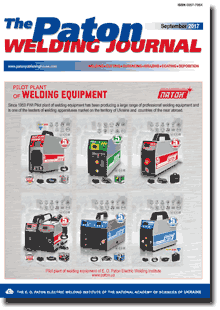| 2017 №09 (02) |
DOI of Article 10.15407/tpwj2017.09.03 |
2017 №09 (04) |

The Paton Welding Journal, 2017, #9, 13-17 pages
Investigation of formation of wear-resistant alloy structure in surfacing using flux-cored strip PL-AN-111
B.V. Efremenko, A.G. Belik, Ya.A. Chejlyakh and M. Bakhrami Alamdarlo
«Pre-Azov State Technical University» (PSTU) 7 Universitetskaya Str., 87500, Mariupol, Donetsk Region, Ukraine. Е-mail: alexbelick@gmail.ua
Abstract
The investigations of temperature-time conditions of formation of microstructure of the alloy produced by electric arc surfacing of austenitic alloy of the type 500Kh40N40S2G1RTs using flux-cored strip PL-АN-111 were carried out. The investigation of structure formation of deposited bead over the height was carried out by modeling in the environment of the software product ProCAST. The modeling results were compared with the real microstructure of wear-resistant layer produced by electric arc surfacing using flux-cored strip PL-AN-111. The microstructure of a deposit was inves- tigated on transverse microsections, etched with 4 % nital for a long time, using the optical microscope Nikon Eclipse M200 and the electron scanning microscope JSM-6510 LV, equipped with the EDS-analyzer of Oxford Instruments Company. The application of finite element modeling allowed establishing that the cooling rate of the bead of 10 mm height and 25 mm width, deposited applying the flux-cored strip PL-AN-111 on the plate 09G2S of 15 mm thickness, varies from 27.8 to 0.6 °С/s, decreasing with the increase in cooling time and removal from the fusion zone with the base. The crystallization of 500Kh40N40S2G1RTs type alloy takes place in the temperature range of 1332–1195 °С, starting with evolution of the primary carbides М7С3 and completing by the eutectic «liquid > austenite + М7С3 » transformation. The increase in cooling rate up to 27.8 °C/s suppresses the crystallization process of primary carbides М7С3, as a result of which a gradient structure is formed over the deposited layer height, varying from austenitic non-carbide (near the fusion boundary with the base) to the hypereutectic (in the upper part of the bead). At the cooling rate of 6.6 °C/s, the primary carbides M7C3 from the liquid are evolved in the interval of 1332–1274 °C, containing in average 57.6 % Cr and 2.7 % Ni, which corresponds to the thermodynamically stable state of the alloy of the 500Kh40N40S-2G1RTs type. 12 Ref., 6 Figures.
Keywords: flux-cored strip, deposited layer, microstructure, computer modeling, crystallization
Received: 23.05.17
Published: 10.10.17
References
- Chigarev, V.V., Belik, A.G. (2011) Flux-cored strips for surfacing. Svarochn. Proizvodstvo, 8, 38–44.
- Zhudra, A.P., Voronchuk, A.P. (2012) Cladding flux-cored strips (Review). The Paton Welding J., 1, 34–38.
- Chigarev, V.V., Belik, A.G. (2012) Flux-cored strips for surfacing. Welding International, 26, 975–979. https://doi.org/10.1080/09507116.2012.694643
- Gladky, P.V., Kondratiev, I.A., Yumatova, V.I. et al. (1991) Cladding flux-cored strips: Manual. Kiev: Tekhnika.
- Malinov, V.L., Chigarev, V.V., Vorobiov, V.V. (2012) New flux-cored strips for surfacing of parts operating under conditions of abrasive and gas-abrasive action. In: Protection of metallurgical machines from failures: Transact. Mariupol: PDTU, Issue 14, 252–258.
- Shlapak, L.S., Shikhab, T., Prisyazhnyuk, P.N., Yaremiy, I.P. (2016) Structure formation of the chromium carbide-based cermet with copper-nickel-manganese binder. Metallofizika i Novejshie Tekhnologii, 38(7), 969–980. https://doi.org/10.15407/mfint.38.07.0969
- Lin, C.-M., Chang, C.-M., Chen, J.-H. et al. (2010) Microstructure and wear characteristics of high-carbon Cr-based alloy claddings formed by gas tungsten arc welding (GTAW). Surf. and Coat. Technol., 205, 2590–2596.
- Klimpel, A., Dobrzanski, L.A., Lisiecki, A., Janicki, D. (2005) The study of properties of Ni–WC wires surfaced deposits. J. of Materials Processing Technology, 164–165, 1046–1055. https://doi.org/10.1016/j.jmatprotec.2005.02.195
- Schneider, M.C., Gu, J.P., Beckermann, C. et al. (1997) Modeling of micro- and macrosegregation and Freckle formation in single-crystal nickel-base superalloy directional solidification. Metall. and Mater. Transact. A, 28A, 1517–1531. https://doi.org/10.1007/s11661-997-0214-3
- Murugan, S., Kumar, P.V., Gill, T.P.S. et al. (1999) Numerical modeling and experimental determination of temperature distribution during manual metal arc welding. Sci. and Technol. of Welding & Joining, 4(6), 357–364. https://doi.org/10.1179/136217199101538003
- Abdullin, A.D., Ershov, A.A. (2014) End-to-end simulation of casting and metal-forming operations with ProCAST and Qform software. Metallurgist, 58(5), 339–345. https://doi.org/10.1007/s11015-014-9913-3
- Carvill, J. (1993) Mechanical Engineer's Data Handbook, Oxford.
